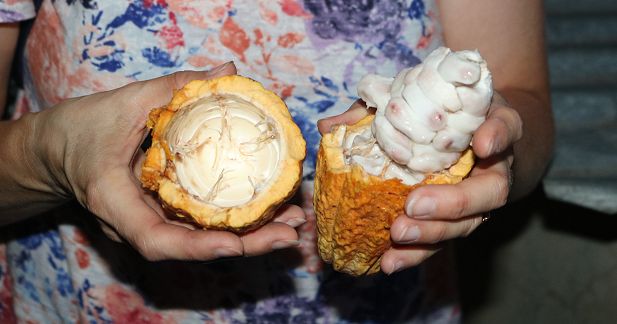Tag Archive: cacao tree
The “Hot” in Hot Chocolate?
October 4, 2012

I am not your typical morning person who opens her eyes the moment the sun shows up. In fact, I am the type who curls myself up in bed and extends a few more minutes. But once I hear my tummy rumbling, begging for food, I summon all my might to pull myself up to grab my energizer buddy, the hot chocolate.
Read more
The Cacao Tree
January 5, 2012
Probably by now, you know that chocolate is made from the fruit of the cacao tree. Let me share some tidbits about all you chocoholics' own version of "tree of life".
Cacao trees are tiny evergreen trees that are only about 6 meters tall. These trees produce fruit and flowers all year round and they are cultivated in countries within 10 degrees North and 10 degrees South of the Equator where the climate is most favorable for the cultivation of cacao trees as they require warm and humid environment. Furthermore, cacao trees need fertile and well-irrigated soil along with regular rainfall to grow their best.
Read more
The Guardian of Chocolate?
November 10, 2011
If you already have gone through the previous blog posts, you may have learned that chocolate can trace its origins back to the Aztecs. They have associated cacao trees with the god of agriculture, Quetzalcoatl. Legend has it that Quetzalcoatl was held responsible for bringing cacao to earth. His actions were frowned upon so he got kicked out of the heavens for giving it to humans. As he escaped, he swore to return one day as a “fair-skinned bearded man” to save the earth.
The earliest Aztecs highly thought of the cacao plant. They considered it as a source of strength and wealth and Quetzalcoatl was said to be its guardian which explains why cacao beans were used as their form of currency.
The Aztecs were among the first ones to work with cacao beans. However, they initially didn’t use this for any culinary purpose whatsoever. They only developed interest in its edibility after observing certain animals, particularly monkeys. This is why only the pulp of the cacao tree was used at first, only after a while did they start utilizing the beans.
Read more
The Beginning of Chocolate
August 25, 2011
Chocolate has been around for millennia now, and the history is extremely long and diverse. The earliest references of chocolate were over fifteen hundred years ago in the Central American Rain Forest, an ideal environment for the cultivation of the Cacao Tree because of the mix of high rain fall, temperature and humidity.
The Mayan culture worshiped the Cacao tree as they believed it was of divine origin and it symbolized life and fertility. Cacao is actually a Mayan word which meant “God Food”, modernly coined as “Food of the Gods”. The Mayans were believed to be brewing and drinking this spicy bittersweet beverage by roasting, grinding and fermenting the seeds of the Cacao Tree. This was intended for the wealthy and elite.
The Aztecs, like Mayans, also have their own version of the fermented drink and they called it Xocolatl, meaning “bitter water”. Their Emperor, Montezuma, allegedly believed that this was an aphrodisiac, and drank almost 50 cups a day. The beans were even used as currency and considered as treasure that when Spaniards came and searched for gold and silver, they found no more than the beans.
Read more
Lost Cacao Rediscovered in Peru
December 30, 2010
A rare variety of cacao called Pure Nacional thought lost or extinct has been rediscovered in Peru.
Pure Nacional, once famous for its fruity and floral flavor notes, was wiped out by disease within a three year time period in Ecuador and Peru. At least 95% of the cacao trees died out during that plague.
However, some unusual cacao trees growing pods containing white beans were discovered in a remote canyon in Peru’s Maranon Canyon. Samples were sent to the United States Department of Agriculture for testing. The USDA recently confirmed these were Pure Nacional variety of cacao.
Read more
Mars Company Receives Award
December 21, 2010
The maker of the Snickers bar, Mars, supports the Sustainable Tree Crops Program in Africa.
The program is based on a partnership with the U.S. Agency for International Development (USAID) and the World Cocoa Foundation. The organizations invest in cacao research and distribute cacao tree seedlings to farmers in order to grow more disease resistant and higher crop-yielding trees.
Read more
Cacao Grown in Fiji
November 23, 2010
There is small chocolate company revitalizing cacao and chocolate production in Fiji.
Adi Chocolate Fiji, is located on the island of Vanua Levu. They make chocolate using two crops grown on the island; Trinitario cacao beans and raw cane sugar.
The owners of the company fell in love with chocolate while running a restaurant and serving homemade chocolate ice cream. In 2007, they began making dark chocolates from their native Fiji cacao.
Read more
Cacao, a Product of Global Warming?
November 16, 2010
There is evidence of a past warming period in Earth’s history. A previous spell of global warming, if you will.
Scientists at the Smithsonian Tropical Research Institute participated with other organizations in a research study to find out what effects global warming on our planet’s past vegetation – and by past, I mean the Paleocene Epoch!
Something really interesting caught my attention as I was reading a summary of the findings. Contrary to the belief that tropical forests were devastated under the conditions of global warming, new plants evolved at a faster rate than ones that became extinct. Pollen from the cacao plant family (and the passionflower plant family) appeared suddenly, for the first time, during this warming event.
Read more
Indonesian Chocolate is Toad-ally OK
September 28, 2010
The Sulawesian toad (Ingerophrynus celebensis) has hero status on cocoa farms in Indonesia.
German and Australian agriculture scientists have discovered the amphibian predator is eliminating a nasty pest to cocoa, the yellow crazy ant (Anoplolepis gracilipes).
The yellow crazy ants got their name from their color and their zigzag scurrying behavior. They are a non-native, invasive insect that can bring devastation to cacao crops. They nest in large supercolonies and have super appetites, too.
Read more


